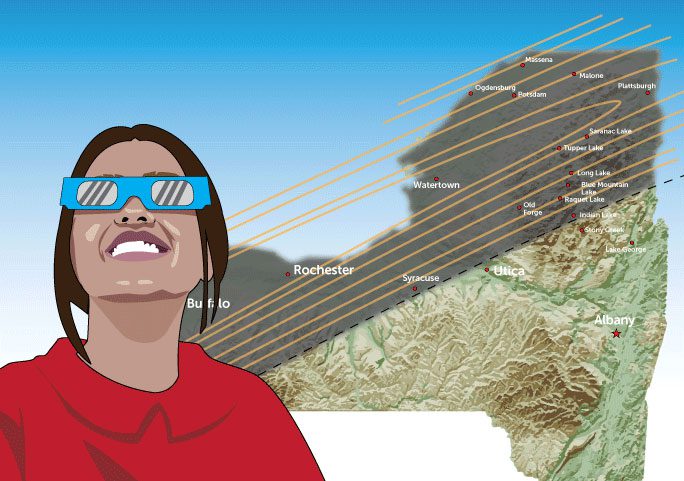The Adirondack Explorer newspaper up in the Adirondacks assigned me to research and write this story on the upcoming April 8, 2024 total solar eclipse. One of the best places in the northeast to view it will be in the Adirondack Mountains.
When the sun, Earth and moon align
What to know about this rare celestial event
By Mark Marchand
Residents and visitors will get a chance this spring to witness a stunning cosmic phenomenon that hasn’t occurred in the Adirondack region for nearly seven centuries. On April 8, a complex orbital dance will produce an astronomical event known as a total solar eclipse, or “totality.”
This rare event gives viewers opportunities to connect with and understand the cosmos and our place in it, regional astronomers and scientists said.
“It’s really just geometry at work,” said Seth McGowan, president of the Adirondack Sky Center & Observatory. His Tupper Lake organization is playing a key role in community planning for eclipse events, including educational talks.
On April 8, a dark shadow—an umbra—caused by the moon temporarily blocking our sun will first touch the southwestern coast of Mexico and race northeast across North America at 2,500 miles per hour before the daytime spell of darkness edges into the Tupper Lake region at 2:12 p.m.
For the next hour, Earth’s natural satellite will block more of the sun until covering the entire surface in Tupper Lake at 3:24 p.m., with maximum totality achieved at 3:26. This totality will last for three minutes and 33 seconds before the umbra continues its path toward the Atlantic Ocean. As the moon reveals more of the sun that day it will create a spectacle known as a diamond ring, as a bright edge of the sun reappears. Outside of the umbra’s path there will be a lighter shadow north and south—a penumbra—caused by the moon partially covering the sun.

St. Lawrence University Physics Professor Aileen O’Donoghue said the mid-day darkness will rapidly cool the area and convince some dogs, birds, insects and other animals to begin evening rituals or display anxiety. These effects and others—which have sparked mysticism wonder, and sometimes fear over millennia —will begin to reverse as the moon reveals more of the sun.
The speeds of the three celestial bodies involved with a solar eclipse are staggering. The sun—and the solar system orbiting around it—barrel through the Milky Way at almost a half million miles per hour. Earth motors around the sun at about 67,000 miles per hour, while the planet’s natural satellite, the moon, spins around us at a relatively pokey 2,400 miles per hour.
The motion of the Earth and moon, combined with their permanent tilts, McGowan said, rarely sync to produce a solar eclipse like the one expected. That eclipse will produce totality because it occurs at a time when the moon is closer to Earth and appears bigger, totally blocking the sun. When the moon is farther from Earth, it appears smaller and causes an annular eclipse, which leaves a bright ring around our star.
While the reactions of living creatures to the sudden daytime darkness is of interest, O’Donoghue said the transient blotting out of the brilliant sun opens new avenues of exploration. As the sun goes about its business of fusing together hydrogen atoms to create helium—releasing astounding amounts of energy in the process—it’s surrounded by an atmosphere of sorts, or corona, that provides clues about our closest star and what’s happening deep below its gaseous surface.
The sun’s eye-scorching brightness normally prevents us from viewing this corona. Through analyzing the wavelengths of light emitted and absorbed, scientists can learn more about the sun and the hazy, ever-moving streams of particles radiating from it.
“We can learn, for example, more about the sun’s magnetic fields,” said O’Donoghue, an Adirondack observatory director. “We can even see the very thin layer of atmosphere just outside the sun. All the colors of the rainbow are produced within the sun, and some of these wavelengths are absorbed as they radiate out into space.”
In 1919, British astronomer Arthur Eddington traveled to Brazil and the tiny island of Principe off the west coast of Africa to observe a solar eclipse and prove Albert Einstein’s Theory of General Relativity. Einstein said light waves next to a massive object like the sun would be bent by gravitational waves. By comparing charts of star locations with positions during the eclipse—which can’t be done while the sun is shining—Eddington detected a shift in the stars’ sites, validating the theory. The result was headlines around the world.
Another area of scientific exploration, according to University at Albany Atmospheric and Environmental Sciences Research Professor Junhong Wang, is what happens to the atmosphere during a solar eclipse’s sudden cooling. Working with a student team, Wang will monitor the eclipse from a school in Belleville. They will launch small balloon-born devices. These radiosondes sense and report on a range of conditions, including temperature, wind and water vapor.
“Having the sun blocked and seeing solar energy gone for even a short time during the day tells us a lot about our environment here on Earth,” Wang said. She and her team will also tap into a statewide network of weather measurements, New York State Mesonet, to track similar data when the umbra first reaches Western New York.
Mark Marchand is a freelance writer in Saratoga County.
Editor’s note: An earlier version of this story misplaced the order of hydrogen converting to helium.
Here’s a link to the story on the Explorer’s website.
